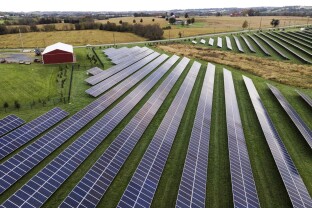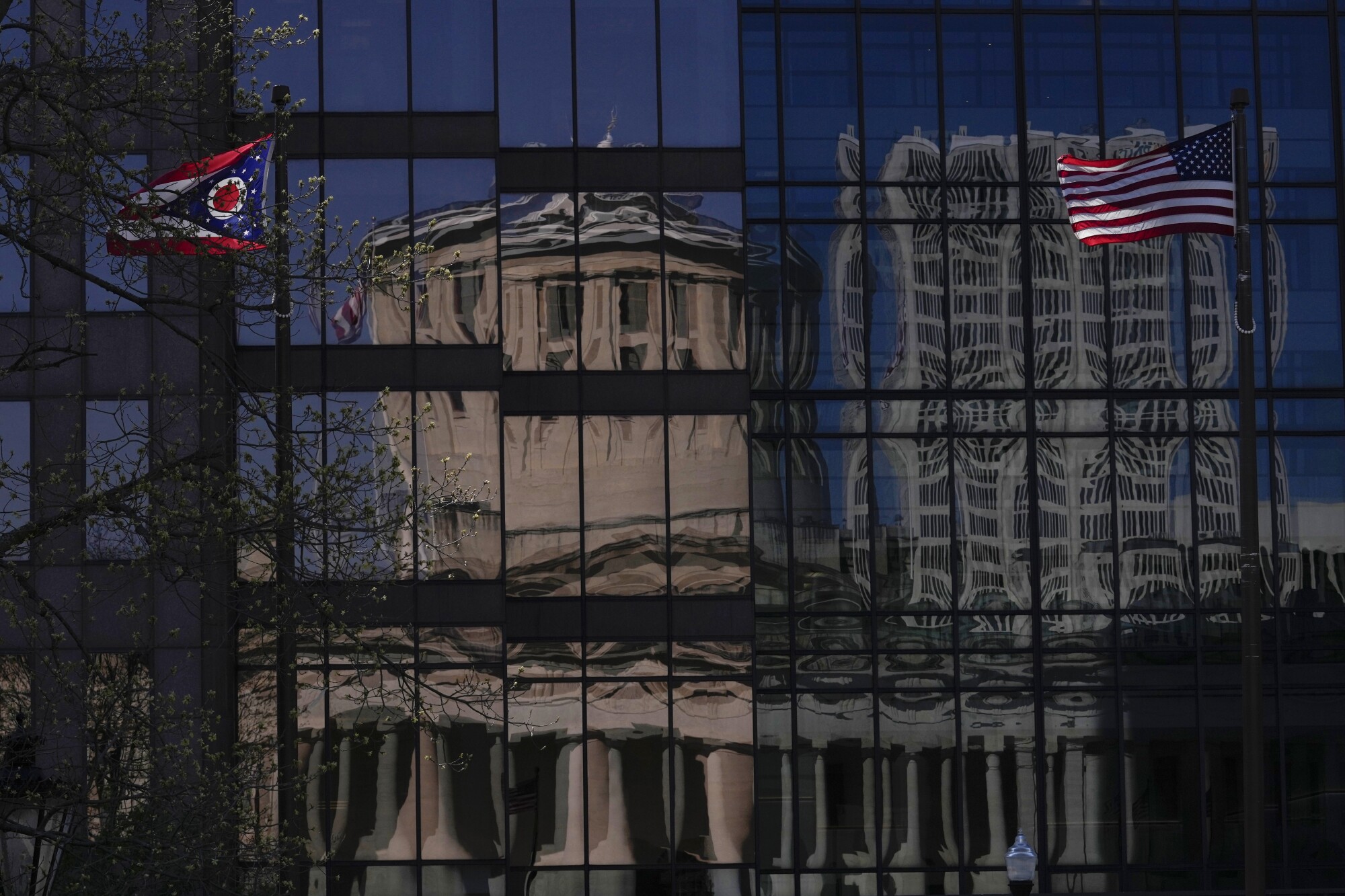Battling medical debt and unpaid bills from their family farm, Wayne and Sara Greier thought they had a chance to start over when they signed a lease to lend their farmland to a $150 million solar project.
Solar company Alpin Sun’s proposal would have erased their financial hardship. Instead, it became the target of a conservative culture war that turned the Greiers into social pariahs and ended with a solar ban in their ruby red northwest Ohio community.
“We’re absolutely hated here. They surrounded our house with signs. Our kids got harassed at school,” Wayne Greier said of Green Township, a community that voted for Donald Trump by 45 points. “I got called a liberal. They kept asking: ‘When did you turn into a liberal? You’ve never been liberal. Why do you want green energy?’”
Two years after the Greiers signed a lease with Alpin Sun, the company was pushed out. The Greiers had to sell 40 acres of land to make ends meet.
A new political reality — one that threatens to doom President Joe Biden’s climate change agenda before it can really begin — has settled in across red America.
In Green Township, where the Greiers live, Alpin Sun’s plan would have powered more than 25,000 homes and given local public schools hundreds of thousands of dollars in tax revenue. Partisan opposition to all things green beat out those incentives.
Ohio’s huge swaths of very flat rural land, already equipped with transmission infrastructure, should be an obvious place to build large, affordable solar projects. But the state has become an early warning sign for those trying to combat climate change. In April 2024, 10 more townships in Mahoning County, Ohio, where Green Township is located, banned all solar development. All told, at least 25 of Ohio’s 88 counties have placed prohibitions on solar development since 2021. Some also include bans on wind.
Renewable energy projects used to be broadly popular among both Democrats and Republicans. Eighty-four percent of Republicans and 94% of Democrats said they supported more solar power just before Biden took office; now 70% of Republicans do, while the Democratic number remained the same, according to a June 28 Pew Research Center survey. The trend was nearly identical for wind power, with Democrats remaining largely in support and Republican support dropping about 15 points.
“I would call this the unnecessary politicization of technology that has environmental, economic and reliability benefits, and we’ve seen that with transmission as well,” said Elise Caplan, the vice president of regulatory affairs for the American Council on Renewable Energy. “It is concerning to a lot of solar developers.”
The Inflation Reduction Act provided massive incentives for clean energy development, and the Biden agencies have been trying to shovel the money out the door before a possible Trump presidency. That money means nothing if local communities turn against the developers.
Across the country, nearly 400 communities (whether that be counties, townships or other municipalities) have passed laws restricting wind and solar development, according to a June 2024 report from Columbia Law School’s Sabin Center. That’s nearly a 75% increase in the number of identified restrictions compared to a previous version of the same report from last year.
Renewable energy developers say that about one-third of their projects proposed over the last five years have been canceled, and local opposition and local laws are two of the top three reasons for those cancellations, according to a January 2024 report from the Lawrence Berkeley National Laboratory. The increasing depth and breadth of local opposition across the United States has become one of the largest and most concerning barriers for a clean energy future, energy developers and policy experts told NOTUS.
***
The opposition to solar in Ohio began with state Senate Bill 52, which explicitly grants counties the right to prohibit large-scale solar and wind development within their boundaries. The bill does not do the same for other forms of energy, like natural gas or coal.
“The state law facilitated local opposition. It elevated local opposition and allowed county governments to block wind and solar projects,” said Matthew Eisenson, one of the authors of the Columbia report and the leader of a legal defense group for clean energy projects.
Ohio is the first state to explicitly remove power from its governing body and grant it to the local communities for renewable energy projects only.
But Ohio might not be the last: The Wisconsin Legislature has also discussed a bill that would shift more power to local governments on solar power, according to Eisenson. Even in blue Connecticut, a bill proposed by the Legislature there would do similar. Some states give local governing bodies significant zoning jurisdiction that can also limit renewable projects.
Wind projects are the most popular targets of opposition across the country. The opposition is almost predictable: Wind turbines are big and aesthetically imposing, critics say, and they risk birds and other wildlife. Trump has gone so far as to baselessly allege that onshore wind turbines can cause cancer and dramatically ding property values and that offshore wind turbines kill whales.
It’s this negative reaction to wind that persuaded some developers to focus on planning solar projects instead, according to the Berkeley National Lab survey. But Ohio is proving that solar is not so safe of a bet.
The story is nearly the same in every community with a proposed solar project. Local residents worry that the project will destroy the rural or natural character of a place or take up valuable land that could be used for growing food. Those fears tend to be rooted in a deeply political, polarized perspective: Many people blame the liberal agenda for bringing these projects to their communities and for threatening their way of life.
The failed attempts at solar development are adding up. In December 2022, Vesper Energy’s Kingwood solar project in Greene County, Ohio, was denied its application for a permit because of overwhelming community opposition. Hundreds of people protested that the rural nature of the community would be irrevocably altered and that food supplies would be limited by turning farmland into solar panels.
The same comments colored the protest against the Greiers’ planned solar project in 2023. “People in Green Township moved there to see cornfields. They moved there to see apple orchards. They did not move there to see solar panels,” one township official said during the debate over the project.
“They said we had to keep it in agriculture,” Wayne Greier said. “I have people I’d been friends with for years who won’t even talk to me.”
A similar fight has exploded over a proposed solar project in one of the places that does not yet have a ban. In April 2024, about 800 people in Mount Vernon, Ohio, attended a community meeting to give comments on the Frasier Solar project. The hearing was eventually suspended after six and a half hours of comments left more than 100 people still in line to participate.
Opposition to the solar project became the primary issue for the county commissioner’s election in March; one candidate said that “foreign corporations want to take our farmland” in a campaign ad opposing the project. The anti-solar movement has been at least partially funded by an anonymous group with ties to the natural gas industry, according to an Energy News Network report.
“It’s comment after comment about loss of farmland, and a lot of it is just really unfounded,” Eisenson said. “It’s something that opponents have really latched on to, and I would say that a majority of the people who oppose these will say something about loss of farmland.”
“Far fewer renewable energy projects are likely to get built than is required to meet our domestic production goals, and that is largely thanks to a recent but expanding alliance between local opposition groups, ideological organizations, and dark money groups funded by the fossil fuel industry,” said Craig Adair, a solar developer with Open Road Renewables.
If all of the solar projects that have been proposed in Ohio were actually built, less than half of 1% of all usable farmland in Ohio would be transformed into a solar facility, several researchers said. But within the bounds of the local community, the scope of farmland turning to solar feels more radical, said Gilbert Michaud, a researcher at Loyola University Chicago who conducts economic development studies for solar energy developers in Ohio. “One solar farm can be a big contribution to one community,” he said.
As more counties in Ohio embrace restrictions, protests and bans, solar developers have backed away from planning new projects in the state. Several developers told NOTUS that building solar was just too hard and that they would hesitate to pursue further projects. The number of proposed solar projects in Ohio has declined sharply over the last year, according to a Bricker Graydon report.
“Ohio is getting harder to build in. All of these counties are putting up these restrictions, and developers don’t want to deal with that, so now they are going to go and try to build elsewhere,” Michaud said.
Some states have responded to the explosion in local opposition with a different strategy. Michigan’s Democratic Legislature, which has watched townships fully restrict solar development in areas zoned for agriculture, responded with a law that curtails local governments from having power over projects over a certain size. That bill will go into effect in November. Illinois did the same last year, following New York and California in the years before that.
“A state acting to be the main authority for siting and permitting of renewables, I think that’s a helpful response,” Caplan of ACORE said. “Something absolutely has to be done to ensure that these projects can move forward.”
The Greiers still dream about Ohio overturning SB 52. But as small-government property rights advocates, they are baffled by the politics and unsure what it might take to change them.
“We are a strong Republican area. It has become: ‘This is the Green New Deal; we must fight it,’” Wayne Greier said. “But this is not part of the Green New Deal. We just want to make the best use of the land where we can produce food and we can produce energy at the same time. It would be the first time we would ever be able to make decent money on our land that we invested in.”
—
Anna Kramer is a reporter at NOTUS.
Sign in
Log into your free account with your email. Don’t have one?
Check your email for a one-time code.
We sent a 4-digit code to . Enter the pin to confirm your account.
New code will be available in 1:00
Let’s try this again.
We encountered an error with the passcode sent to . Please reenter your email.



